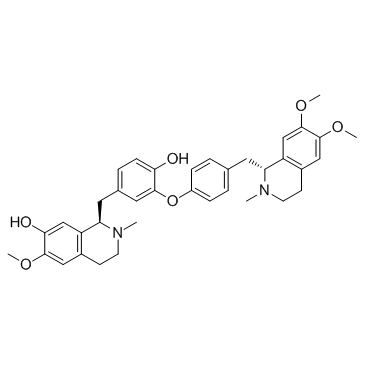Daurisoline

Daurisoline structure
|
Common Name | Daurisoline | ||
|---|---|---|---|---|
| CAS Number | 70553-76-3 | Molecular Weight | 610.739 | |
| Density | 1.2±0.1 g/cm3 | Boiling Point | 724.5±60.0 °C at 760 mmHg | |
| Molecular Formula | C37H42N2O6 | Melting Point | 96-102ºC | |
| MSDS | Chinese USA | Flash Point | 392.0±32.9 °C | |
Use of DaurisolineDaurisoline is a hERG inhibitor and also an autophagy blocker. |
| Name | daurisoline |
|---|---|
| Synonym | More Synonyms |
| Description | Daurisoline is a hERG inhibitor and also an autophagy blocker. |
|---|---|
| Related Catalog | |
| Target |
hERG[1], autophagy[2] |
| In Vitro | Daurisoline (compound 1) shows a maximal inhibitory effect on the end of depolarization (IhERG-step) at +20 mV and on the peak tail current (IhERG-tail) at +60 mV. At concentrations of 1, 3, 10, and 30 μM, the inhibition ratios for current amplitude at the end of depolarization (IhERG-step) are 32.2±4.2%, 41.6±2.6%, 62.1±5.9%, and 74.8±6.8%, respectively; the IC50 is 9.1 μM. In turn, the inhibition ratios for IhERG-tail are 16.7±5.8%, 31.1±4.5%, 55.1±7.2%, and 81.2±7.0%, respectively; the IC50 is 9.6 μM[1]. Daurisoline (DAS) inhibits the CPT-induced autophagy in different cancer cell lines, with IC50s of 74.75±1.03, 50.54±1.02 and 80.81±1.10 μM in HeLa, A549 and HCT-116 cells, respectively. DAC and Daurisoline also impair lysosomal function and lysosomal acidification, via inhibiting the lysosome V-type ATPase acitivity in DAC and Daurisoline treated cells[2]. |
| In Vivo | The results show that plasma concentration exists a biexponential decline following iv administration of Daurisoline (DS) or dauricine (Dau) 6 mg/kg. After iv Daurisoline and Dau 6 mg/kg in beagle dogs, HR, LVSP, dp/dtmax, and SBP are decreased. But the maximum pharmacological effects of both drugs peak at 10 to15 min later than the maximum plasma concentration is observed[3]. |
| Kinase Assay | HEK293 cells are incubated overnight with 35 μg/mL Dx-OG514. Cells are washed and incubated with serum-free Dulbecco's modified Eagle's medium (DMEM) for 2 h. 15 minutes prior to lysis, FCCP is added into the medium to a final concentration of 1 μM. Cells are scraped in fraction buffer (50 mM KCl, 90 mM K-Gluconate, 1 mM EGTA, 50 mM Glucose, 20 mM HEPES, protease inhibitor cocktail, pH=7.4) supplemented with 1 μM FCCP. After spraying with needle, cells are spun down at 10,000 rpm for 15 sec. at 4°C. Then, re-centrifuge the supernatant at max speed for another 20 minutes. The pellet is resuspended in pre-warmed fractionation buffer supplemented with 1% BSA, and split into several aliquots with DAC, Daurisoline (DAS) or BAF treatment for 30 min. Baseline fluorescence is measured at 530 nm upon 511 nm excitation in 96-well plate at 30 s intervals for 5 min[2]. |
| Cell Assay | Cell proliferation is determined by the 3-(4,5-dimethylthiazol-2-yl)-2,5-diphenyltetrazolium bromide (MTT) assay. HeLa cells are seeded at 7000 cells per well in 96-well plates in DMEM (1% serum). After cells are treated with different compounds (including Daurisoline) for indicated times, 20 μL of MTT (2.5 mg/mL in PBS) is added to each well. The plates are incubated for an additional 4 h at 37°C. Then the purple-blue MTT formazan precipitate is dissolved in 100 μL DMSO. The cell viability of HeLa cell is evaluated by measuring optical density at 572 nm with a microplate reader[2]. |
| Animal Admin | After the beagle dogs are anesthetized with sodium pentobarbital (30 mg/kg, iv) a canula is advanced into the left ventricle through the right common carotid artery. And the canula is connected to a pressure transducer which is connected to an amplifier and polygraph. The right femoral artery is canulated to measure the blood pressure wave. ECG (lead II) is observed simultaneously. After iv injection of Daurisoline (DS) (n=4) or Dau (n=4) to beagle dogs, the ECG, BP, and LVP signals are recorded. Blood samples are taken before dosing and at 2, 5, 10, 15, 20, 30, 45 min, and 1, 1.5, 2, 3, 4, 6, 8 h after dosing[3]. |
| References |
| Density | 1.2±0.1 g/cm3 |
|---|---|
| Boiling Point | 724.5±60.0 °C at 760 mmHg |
| Melting Point | 96-102ºC |
| Molecular Formula | C37H42N2O6 |
| Molecular Weight | 610.739 |
| Flash Point | 392.0±32.9 °C |
| Exact Mass | 610.304260 |
| PSA | 83.86000 |
| LogP | 5.84 |
| Vapour Pressure | 0.0±2.4 mmHg at 25°C |
| Index of Refraction | 1.618 |
| Storage condition | ?20°C |
| Water Solubility | DMSO: soluble15mg/mL, clear |
CHEMICAL IDENTIFICATION
HEALTH HAZARD DATAACUTE TOXICITY DATA
|
| Safety Phrases | 24/25 |
|---|---|
| RIDADR | NONH for all modes of transport |
| RTECS | NX5995000 |
|
Pharmacokinetic-pharmacodynamic modeling of daurisoline and dauricine in beagle dogs.
Acta Pharmacol. Sin. 24(10) , 1011-5, (2003) To study the combined pharmacokinetic-pharmacodynamic (PK-PD) model of daurisoline and dauricine, and compare their effects on cardiac electrophsiology, blood pressure, and hemodynamics in beagle dogs... |
|
|
Effects of daurisoline on intracellular Ca2+ activity in myocardium.
Zhongguo Yao Li Xue Bao 17(3) , 248-51, (1996) To explain the effect of daurisoline (DS) on delayed afterdepolarization (DAD).Ca(2+)-sensitive microelectrode technic was used to record intracellular Ca2+ activity (alpha Cai) and triggered activity... |
|
|
Effects of the putative P-type calcium channel blocker, R,R-(-)-daurisoline on neurotransmitter release.
Naunyn Schmiedebergs Arch. Pharmacol. 352(6) , 670-8, (1995) The alkaloid and medicinal herb constituent, R,R-(-)-daurisoline, was originally reported to be a N-type Ca2+ channel blocker, but newer evidence indicates that it is a blocker of P-type Ca2+ channels... |
| 7-Isoquinolinol, 1,2,3,4-tetrahydro-1-[[4-hydroxy-3-[4-[[(1R)-1,2,3,4-tetrahydro-6,7-dimethoxy-2-methyl-1-isoquinolinyl]methyl]phenoxy]phenyl]methyl]-6-methoxy-2-methyl-, (1R)- |
| (1R)-1-[3-(4-{[(1R)-6,7-Dimethoxy-2-methyl-1,2,3,4-tetrahydro-1-isoquinolinyl]methyl}phenoxy)-4-hydroxybenzyl]-6-methoxy-2-methyl-1,2,3,4-tetrahydro-7-isoquinolinol |
| (1R)-1-[3-(4-{[(1R)-6,7-Dimethoxy-2-methyl-1,2,3,4-tetrahydroisoquinolin-1-yl]methyl}phenoxy)-4-hydroxybenzyl]-6-methoxy-2-methyl-1,2,3,4-tetrahydroisoquinolin-7-ol |

